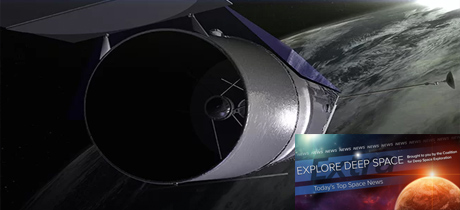In Today’s Deep Space Extra… NASA will return a piece of Mars aboard its next Red Planet rover mission. With some serious cost cutting and restructuring, NASA’s WFIRST space telescope might survive a proposed cancellation to carry out its dark energy mission.
Human Space Exploration
The Greatest Leap, part 6: After Apollo, NASA still searching for an encore
Ars Technica (2/13): The last in a six part retrospective on the U.S. space program looks at one possible future for U.S. human space exploration through the remarkable lens of the Cold War era Apollo moon missions and those who made them happen. Might a tech savvy U.S. private sector and China’s ascendancy offer the best hope for achieving the next leap?
Soyuz rocket launches cargo freighter to International Space Station
Spaceflightnow.com (2/13): A Russian Progress re-supply mission is scheduled to carry out an automated docking with the International Space Station early Thursday. The cargo vessel lifted off atop a Soyuz rocket from the Baikonur Cosmodrome in Kazakhstan Tuesday with three tons of propellant and crew supplies, following a failed launch attempt on Sunday.
Space Science
What would it mean for astronomers if the WFIRST space telescope is killed?
Space.com (2/13): Just out, the Trump administration’s proposed 2019 budget for NASA would terminate work on WFIRST, an ambitious space observatory ranked as a top priority by the National Academy of Sciences. On a par with the Hubble Space Telescope, WFIRST’s mission is to observe the most distant star systems, assess dark energy and search for small extra solar planets and determine their potential to host habitable environments. Some believe the mission could proceed if planners heed a warning to address cost and technical challenges.
NASA/Jet Propulsion Laboratory (2/13): Sayh al Uhaymir008, a fragment from a meteorite of Martian origins gathered up in 1999 from Oman will be returning to the red planet aboard NASA’s Mars 2020 rover. The sample will help the rover identify samples of Martian rock and soil to be gathered and cached on the red planet by the rover for eventual return to Earth.
NASA’s $1 billion Jupiter probe has taken gorgeous new photos of the giant planet
Business Insider (2/13): Launched on August 5, 2011, NASA’s Juno mission spacecraft has transmitted its latest round of close up photos of giant Jupiter, close-ups of the swirling and colorful cloud tops. The work of orbiting once every 53 1/2 days began after a five year journey from Earth.
Europa lander mission shut out again in 2019 NASA budget request
Space.com (2/13): The Trump administration’s proposed 2019 budget for NASA will continue work on a multiple flyby mission of Jupiter’s ice and ocean covered moon Europa, the $2 billion Europa Clipper. However, as was the case in 2018, there’s not yet startup funding for a Europa lander.
NASA prepares Mars Reconnaissance Orbiter (MRO) to support future missions
Spaceflightinsider.com (2/11): NASA’s Jet Propulsion Laboratory is taking measures to extend the operating life of the already long lived Mars Reconnaissance Orbiter, which maneuvered into orbit around the red planet in 2006 for close up reconnaissance of the surface. The work will help preserve MRO as a critical communications relay between future missions and Earth based control teams and scientists.

